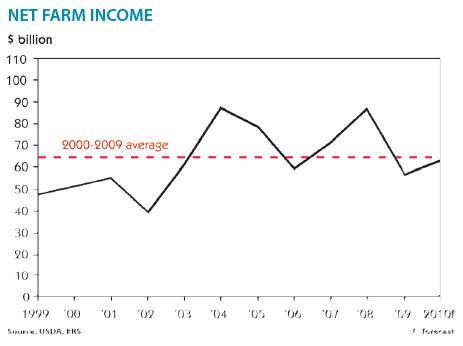USDA farm income report shows modest rebound
By American Farm Bureau Federation

Economists often like to point out that we have two hands. “On the one hand,” they’ll say as they state a fact, and then they’ll introduce an alternative viewpoint with “on the other hand.” So it’s no surprise that many of the predictions in USDA’s recent farm income forecast, released on Feb. 11, are both positive and negative, depending on which “hand” you look at.
USDA farm income report shows modest rebound Continued from page 1 USDA has forecast net farm income of $63 billion in 2010, a $6.7 billion (11.8 percent) increase from 2009. That’s welcome news after last year’s drop of more than 20 percent. On the other hand, the 2010 forecast is still far below the $87.1 billion farmers and ranchers earned in 2008.
On one hand, the forecast for this year is $1.4 billion below the average of $64.5 billion in net farm income earned in the previous 10 years. On the other hand, USDA’s economists say that the 2010 forecast is the fifth-largest amount of income earned in U.S. farming.
Last year farmers and ranchers were affected by a demand squeeze due to the economic recession. Demand for higher-end beef and pork, cheese and other dairy products shrank in 2009 as consumers ate out less and looked for ways to cut their grocery bills.
Bob Young, American Farm Bureau Federation chief economist, says the latest USDA forecast shows that the predictions of late last year that the agricultural economy would start to rebound in 2010 are coming true, but they also support the prediction that the recovery won’t be a quick one.
“This forecast is definitely good news for producers. Toward the end of last year we became optimistic that the agricultural market had already hit bottom,” said Young. “This forecast bears out that expectation. It is important to remember, though, that this is only a forecast. Different weather and production levels could change the picture. It’s still too early to take this to the bank.” The improvements will come mostly from the livestock sector, which suffered the biggest price drops in 2009. On the other hand, producers of several crops, particularly wheat and soybeans, are expected to experience price drops in 2010. The wheat price is expected to decline 34 cents a bushel as quantities sold, domestic demand and exports fall. Soybean prices are expected to fall 58 cents per bushel.
Sales of corn for grain are expected to decline 1 cent per bushel from 2009, but a decline of 1.6 percent in the quantity of corn sold is expected to take a bigger bite out of corn cash receipts. Demand for U.S. cotton is expected to be at the lowest point since 1988 and U.S. cotton exports are forecast at their lowest levels since 2001-02. However, a 2.5 percent decline in the amount of lint sold is expected to cut supply and lift prices by 10 cents per pound.
USDA forecast government farm payments would not change much this year. The department said a projected increase of $1.3 billion in ad hoc and emergency assistance payments would be more than offset by lower payments in other programs, particularly the Milk Income Loss Contract program, the certificate exchange program and countercyclical payments program.
“I think it’s important to stress that point as we seek ad hoc assistance for crop producers who have dealt with too much rain and other natural disasters,” said Tara Smith, AFBF farm policy specialist.
Dairy farmers have survived the worst milk prices since the 1970s, and so the prediction that dairy cash receipts could increase more than $7 billion in 2010 is especially welcome. USDA expects a $4-per-hundredweight (cwt.) increase in the annual average milk price this year as dairy product exports pick up and the number of milk cows declines 228,000 from 2009.
Also good news for livestock producers is the predicted drop of $1.1 billion (2.4 percent) in feed expenses. Feed prices began falling last year after shooting up $18.9 billion (67 percent) from 2005 to 2008.
As exports of beef increase nearly 8 percent, USDA is also forecasting a $2.5 billion increase in cattle cash receipts, with the price for cattle forecast to go up by about $6.22 per cwt. The price of pork is expected to increase by $3.77 per cwt. as pork production declines slightly (2.8 percent). Small increases are expected for poultry and egg receipts, as well.
Of course, the expenses side of the ledger is just as important to farmers’ and ranchers’ bottom lines as cash receipts. USDA says production expenses in 2010 will rise a bit, but less than 1 percent. The bad news is expenses will still be at the second highest level ever. On the other hand, the good news is that the increase in income exceeds the increase in production expenses, which was not the case in 2009.
“Last year will go down in the record books as one of the toughest years farmers have had since the Great Depression,” said Young. “This year won’t be great, but it certainly will be an improvement.”
Disclaimer: Articles featured on Oregon Report are the creation, responsibility and opinion of the authoring individual or organization which is featured at the top of every article.

